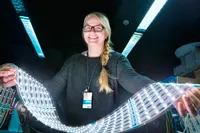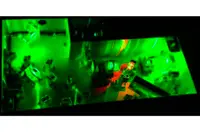Electronics News
Archive : 27 April 2015 год
 A research team, headed by James Hone from the University of Columbia in the US, has shown that the performance of molybdenum disulphide (MoS2), a two-dimensional material, can be improved by encapsulating it in boron nitride.
A research team, headed by James Hone from the University of Columbia in the US, has shown that the performance of molybdenum disulphide (MoS2), a two-dimensional material, can be improved by encapsulating it in boron nitride.
In 2013, Hone's team demonstrated it could improve the performance of graphene by encapsulating it in boron nitride, an insulating material with a similar layered structure.
"These findings provide a demonstration of how to study 2D materials," said Hone, director of Columbia's Materials Research Science and Engineering Center. "This holds great promise for a range of applications including high-performance electronics, detection and emission of light, and chemical/bio-sensing."
In the new work, Hone's team – which includes scientists from Harvard, Cornell, University of Minnesota, Yonsei University, Danish Technical University and the Japanese National Institute of Materials Science – created layered stacks of MoS2 encapsulated in boron nitride, with small flakes of graphene overlapping the edge of the MoS2 to act as electrical contacts.
"We wanted to see what we could do with MoS2, said Gwan-Hyoung Lee, assistant professor of materials science at Yonsei. "It's the best studied 2D semiconductor, and, unlike graphene, it can form a transistor that can be switched fully 'off' – a property crucial for digital circuits."
The researchers found that room temperature mobility was improved by a factor of two. Upon cooling to low temperature, the mobility increased, reaching values of up to 50 times those measured previously. These samples also showed strong oscillations in resistance with magnetic field, which had not been seen in any 2D semiconductor.
Hone concluded: "With further progress, we hope to establish 2D semiconductors as a new family of electronic materials that rivals the performance of conventional semiconductor heterostructures."
Author
Tom Austin-Morgan
Source: www.newelectronics.co.uk
 Launched at the beginning of the year, the European OptIntegral project uses a manufacturing process based on in-mould hybrid integration of thin, organic and large area electronics and photonics components.
Launched at the beginning of the year, the European OptIntegral project uses a manufacturing process based on in-mould hybrid integration of thin, organic and large area electronics and photonics components.
This enables manufacturing of LED displays at lower cost and higher display resolution than is currently possible. The optics are moulded directly onto a bendable LED substrate in an injection moulding process. This is said to make the displays energy-efficient, lightweight, bendable and even three dimensional.
The three year project will develop flexible illuminated advertisement boards suited for transport and other applications requiring lightweight, 3D designs. The LED display is designed to give the viewers a 3D experience without having to wear special glasses.
As part of the project, Finnish based VTT Technical Research Centre will develop a roll to roll manufacturing process for the bendable LED substrates. VTT is also integrating the in mould hybrid technology into the process, enabling future mass production and cost savings.
Author
Tom Austin-Morgan
Source: www.newelectronics.co.uk
 Terahertz waves are beginning to be used in everyday applications within the security sector, for security screening, and the medical field to replace the more harmful X-ray.
Terahertz waves are beginning to be used in everyday applications within the security sector, for security screening, and the medical field to replace the more harmful X-ray.
Now, chemists at Caltech have created a frequency comb that precisely generates and detects terahertz waves. The device uses ultrafast pulsed lasers, or oscillators, to produce thousands of frequencies of radiation distributed evenly across a spectrum.
The comb's 'teeth' are evenly spaced from 0.15 to 2.4THz, giving scientists a way to test 10,000 frequencies at once.
The comb has already sped up astrochemical research into stellar nurseries by determining the kinds of molecules that are present in fledgling planetary systems.
In addition, the terahertz comb will also be useful for studying fundamental interactions between molecules. Terahertz frequencies are said to be the only direct way to look not only at vibrations within individual large molecules that are important to life, but also at vibrations between different molecules that govern the behaviour of liquids such as water.
Using this method, terahertz radiation could detect difference in water density in soft tissue which could allow the non-invasive detection of such diseases as skin cancer.
Author
Tom Austin-Morgan
Source: www.newelectronics.co.uk

